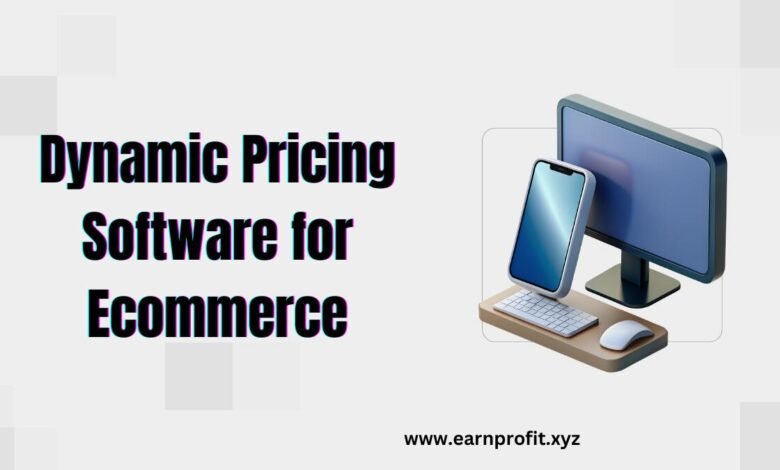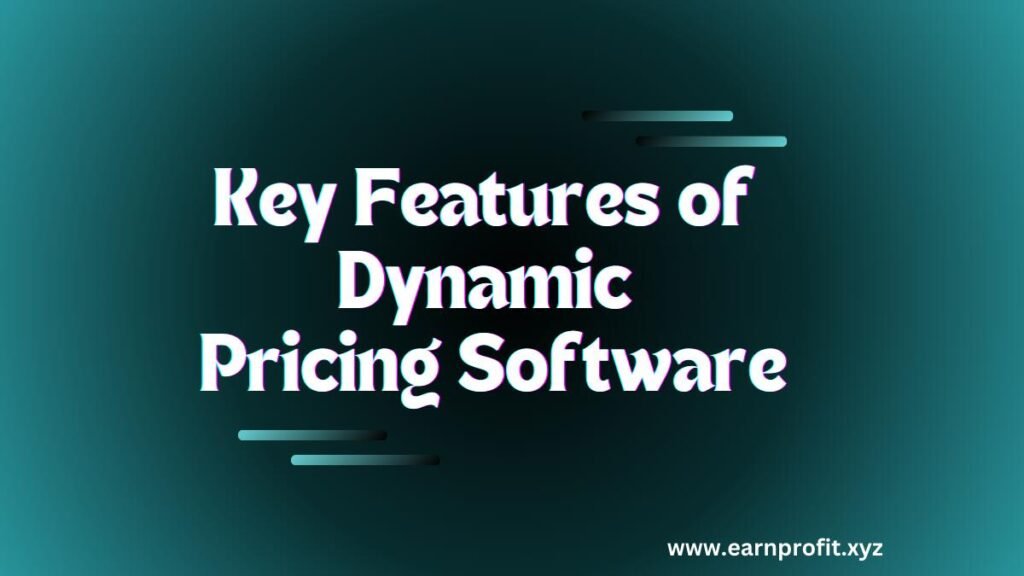Dynamic Pricing Software for Ecommerce: How to Increase

Dynamic pricing software for ecommerce, keeping up with market trends, customer expectations, and competitor pricing can be a huge challenge. This is where dynamic pricing software steps in as a game-changer. This tool allows ecommerce businesses to adjust prices in real-time, optimize profits, and stay competitive without the need for constant manual updates. In this article, we will explore dynamic pricing software, focusing on how it works, its benefits, and why it’s an essential asset for online retailers today. We’ll also discuss some key LSI (Latent Semantic Indexing) keywords related to this topic, such as automated tools, real-time price optimization, ecommerce price intelligence, competitive, and price monitoring.
What is Dynamic Pricing Software?
Tool used by ecommerce businesses to automatically adjust product prices based on various factors such as market demand, competitor pricing, and customer behavior. This system makes it easier for businesses to optimize their pricing strategy, ensuring they’re neither overpricing nor underpricing their products. Unlike traditional pricing methods, which involve setting fixed prices and adjusting them manually, dynamic pricing allows for real-time changes. The software utilizes algorithms, data analytics, and AI (Artificial Intelligence) to monitor external and internal factors, adjusting prices accordingly.
How Does Dynamic Pricing Work?
Dynamic pricing is powered by a combination of data analytics, machine learning, and AI. The software collects data from various sources, including competitors’ prices, customer preferences, stock levels, and market trends. Once this data is gathered, the software analyzes it to determine the most optimal price for each product. The algorithm then adjusts prices automatically to maximize profits, attract more customers, or achieve other business objectives. For example, if a competitor lowers the price of a similar product, dynamic pricing software will adjust your price to remain competitive, ensuring you don’t lose potential customers.
Must Visit: Pinterest
Key Features of Dynamic Pricing Software

Real-Time Price Optimization
One of the most powerful features of dynamic pricing software is real-time price optimization. This means that prices are continuously adjusted based on real-time data, which ensures your prices remain competitive at all times. With real-time price optimization, businesses can respond instantly to changes in market conditions, competitor pricing, or customer demand.
Automated Pricing Tools
Automated pricing tools are essential components of dynamic pricing software. These tools eliminate the need for manual intervention in pricing decisions. With automated pricing, the software sets the most profitable price based on pre-defined rules and market data.
Ecommerce Price Intelligence
Price intelligence refers to the process of collecting and analyzing competitive pricing data. Dynamic pricing software includes ecommerce price intelligence capabilities, allowing businesses to stay informed about how competitors are pricing similar products. This data can be invaluable for making informed pricing decisions and gaining a competitive edge in the market.
Competitive Pricing Software
Staying ahead of competitors is crucial for success in ecommerce. Competitive pricing software is designed to monitor competitors’ prices and adjust your pricing strategy accordingly. With this feature, businesses can ensure that their prices are always in line with the competition, avoiding situations where they lose customers due to overpricing or miss out on profits due to underpricing.
Dynamic Price Monitoring
Dynamic price monitoring allows businesses to keep track of their pricing in real time. This feature helps monitor changes in prices across various channels, ensuring that there are no discrepancies between platforms or regions. Dynamic price monitoring also ensures that pricing remains aligned with business goals, whether that’s maximizing revenue, increasing market share, or clearing out inventory.
Benefits of Dynamic Pricing Software in Ecommerce
Increased Profit Margins
One of the most significant advantages of dynamic pricing software is its ability to increase profit margins. By setting the most optimal price based on real-time data, businesses can sell products at the best price point, ensuring they maximize revenue without deterring potential buyers. This level of pricing precision simply isn’t possible with manual methods.
Better Competitiveness
In the highly competitive ecommerce landscape, staying ahead of competitors is critical. Dynamic pricing software helps businesses stay competitive by continuously adjusting prices based on competitors’ pricing strategies. Whether competitors are offering discounts or adjusting their prices, dynamic pricing ensures your business remains competitive without manual intervention.
Improved Customer Satisfaction
While it might seem like constant price fluctuations could confuse customers, dynamic pricing can actually improve customer satisfaction when done correctly. By adjusting prices based on demand and market conditions, businesses can offer the best value to their customers. This, in turn, can lead to increased loyalty and repeat purchases.
Time Efficiency
Manual price adjustments can be time-consuming and prone to errors. automates this process, allowing businesses to focus on other critical areas of their operations. With automated pricing tools, businesses can ensure their pricing strategy is always up to date without dedicating significant time or resources.
Enhanced Market Responsiveness
In ecommerce, market trends can change in an instant. Dynamic pricing allows businesses to respond quickly to changes, whether it’s a sudden increase in demand for a product or a competitor launching a sale. Being able to adjust prices in real-time helps businesses stay agile and capitalize on market shifts as they happen.
Implementing Dynamic Pricing Software

Customer Perception
One of the challenges of using dynamic pricing is managing customer perception. Some customers may feel frustrated if they see a product’s price fluctuating frequently. It’s essential to implement dynamic pricing in a way that doesn’t alienate your customer base. Communicating the value of the product and ensuring transparent pricing can help alleviate these concerns.
Integration with Existing Systems
Integrating dynamic pricing software with your existing ecommerce platform can sometimes be complex, especially if your systems are outdated. Ensuring that your pricing software integrates smoothly with your current infrastructure is crucial for a seamless experience.
Over-Reliance on Automation
While automation is a significant advantage, over-relying on it can also pose a risk. It’s essential to continuously monitor your pricing strategy to ensure the software is meeting your business objectives. Regular audits of pricing data and strategy are recommended to avoid any potential issues.
How to Choose Right Dynamic Pricing Software
Choosing the right dynamic pricing software depends on several factors, including the size of your business, the complexity of your product catalog, and your pricing goals. When evaluating different software options, consider the following:
Ease of Integration
he software should integrate smoothly with your existing ecommerce platform.
Conclusion
Dynamic pricing software is an essential tool for ecommerce businesses looking to stay competitive, maximize profits, and respond to market changes in real time. By leveraging real-time price optimization, automated pricing tools, and ecommerce price intelligence, businesses can implement a more effective and profitable pricing strategy. However, it’s essential to choose the right software, monitor customer perception, and ensure that automation works in alignment with your overall business goals.
FAQs
How does dynamic pricing software help increase profits?
Dynamic pricing software optimizes pricing based on real-time data, ensuring products are priced at the most profitable point without losing customer interest.
Can dynamic pricing software work for small ecommerce businesses?
Yes, dynamic pricing software is scalable and can benefit businesses of all sizes by automating pricing and optimizing profits.
Is dynamic pricing fair to customers?
When implemented correctly, dynamic pricing can be fair and beneficial to customers, as it adjusts prices based on demand and market trends, offering the best value.
How often does dynamic pricing software update prices?
The frequency of updates depends on the software settings, but typically, dynamic pricing software can adjust prices in real time or at predefined intervals.
What industries benefit most from dynamic pricing software?
While ecommerce is a primary beneficiary, industries such as travel, hospitality, and entertainment also gain from dynamic pricing by responding to fluctuating demand.
Read More: Best Marketing Promotion Ideas





